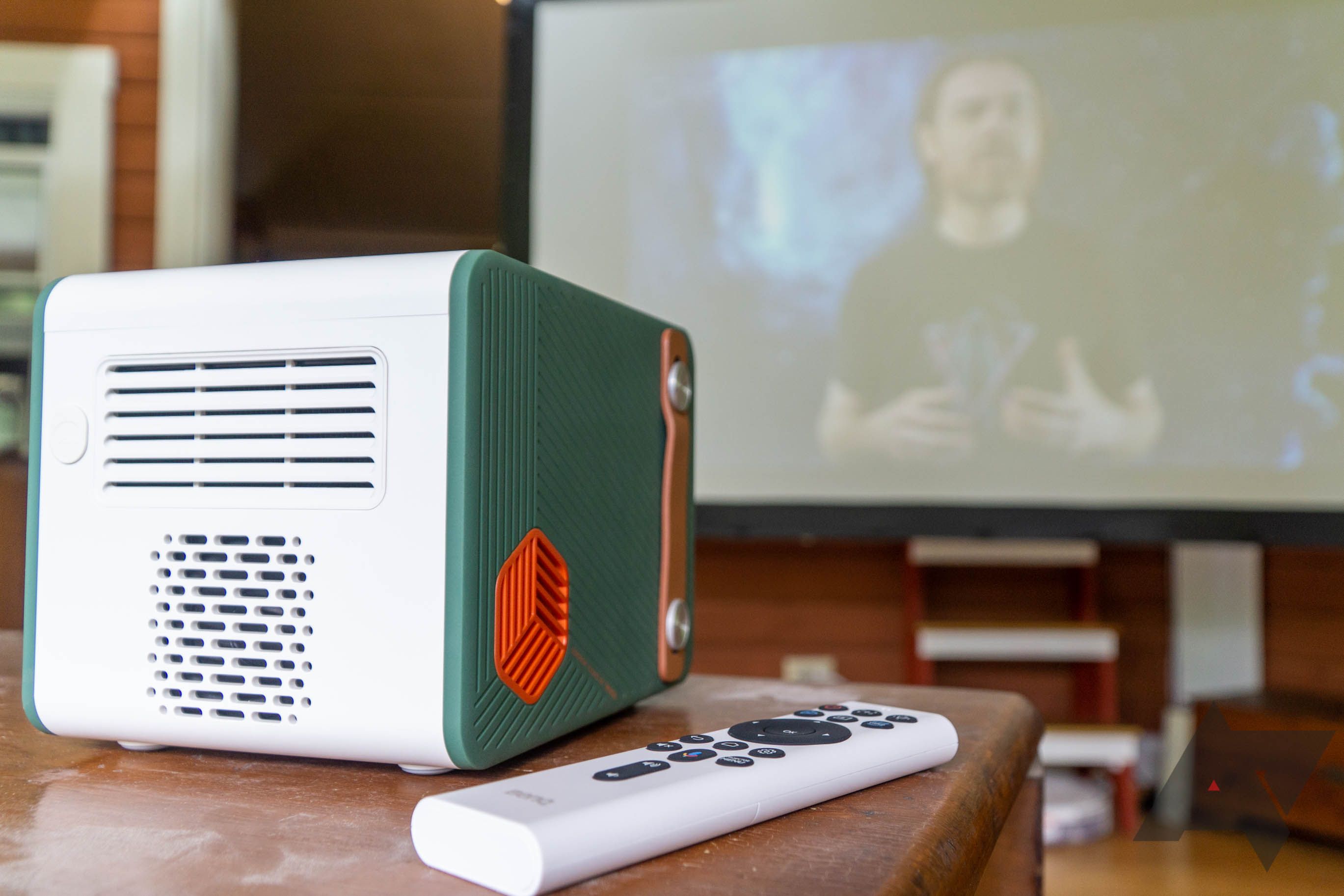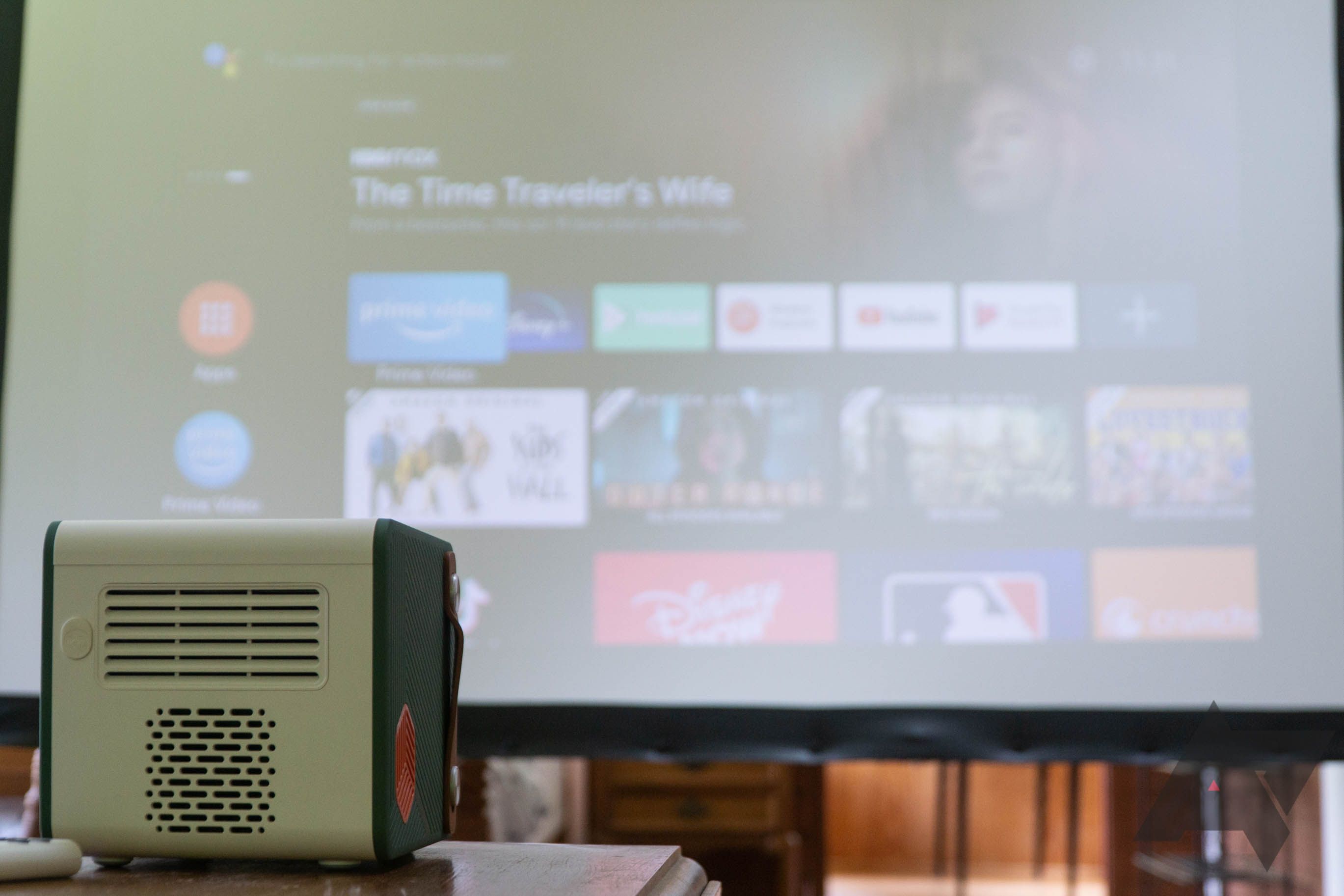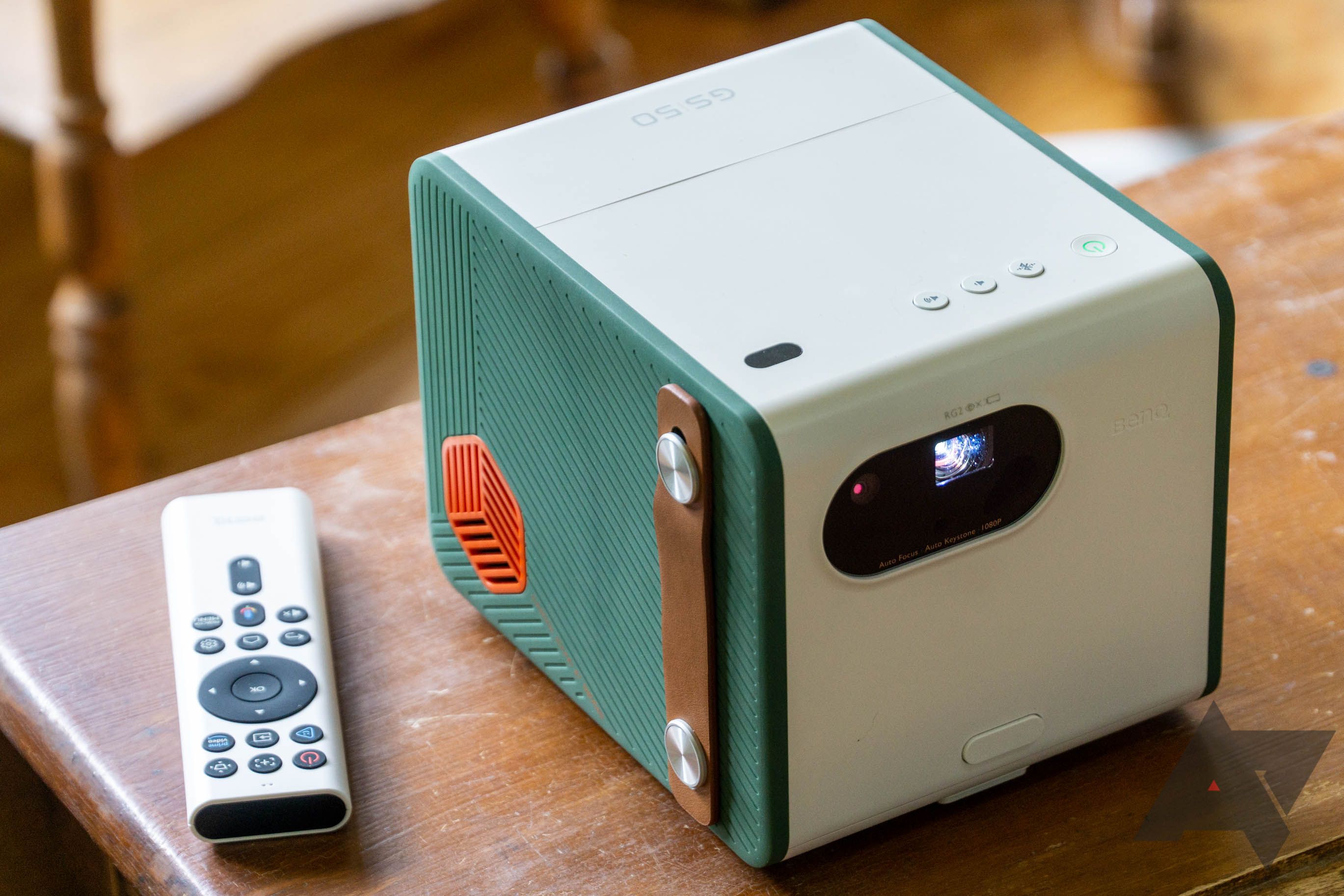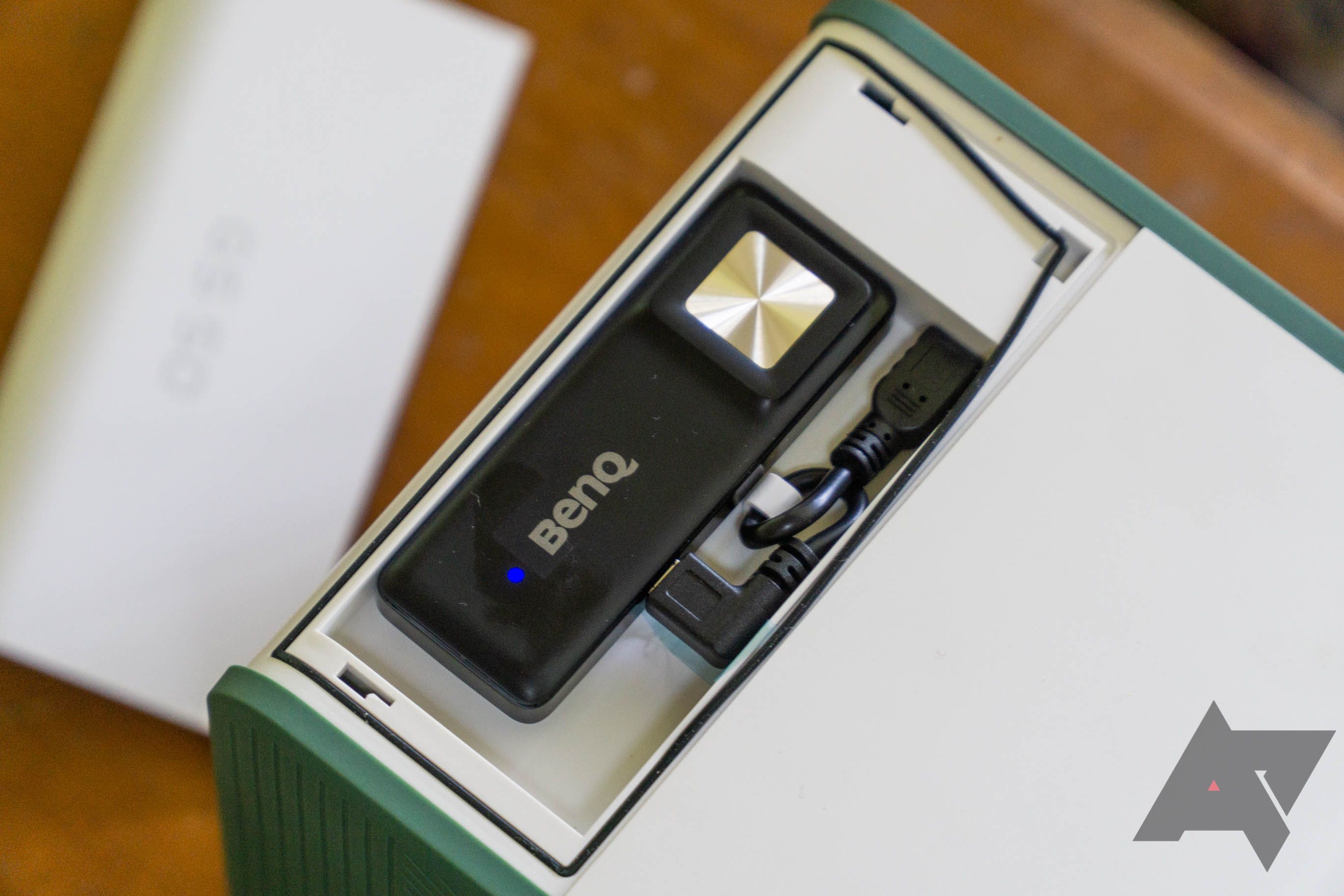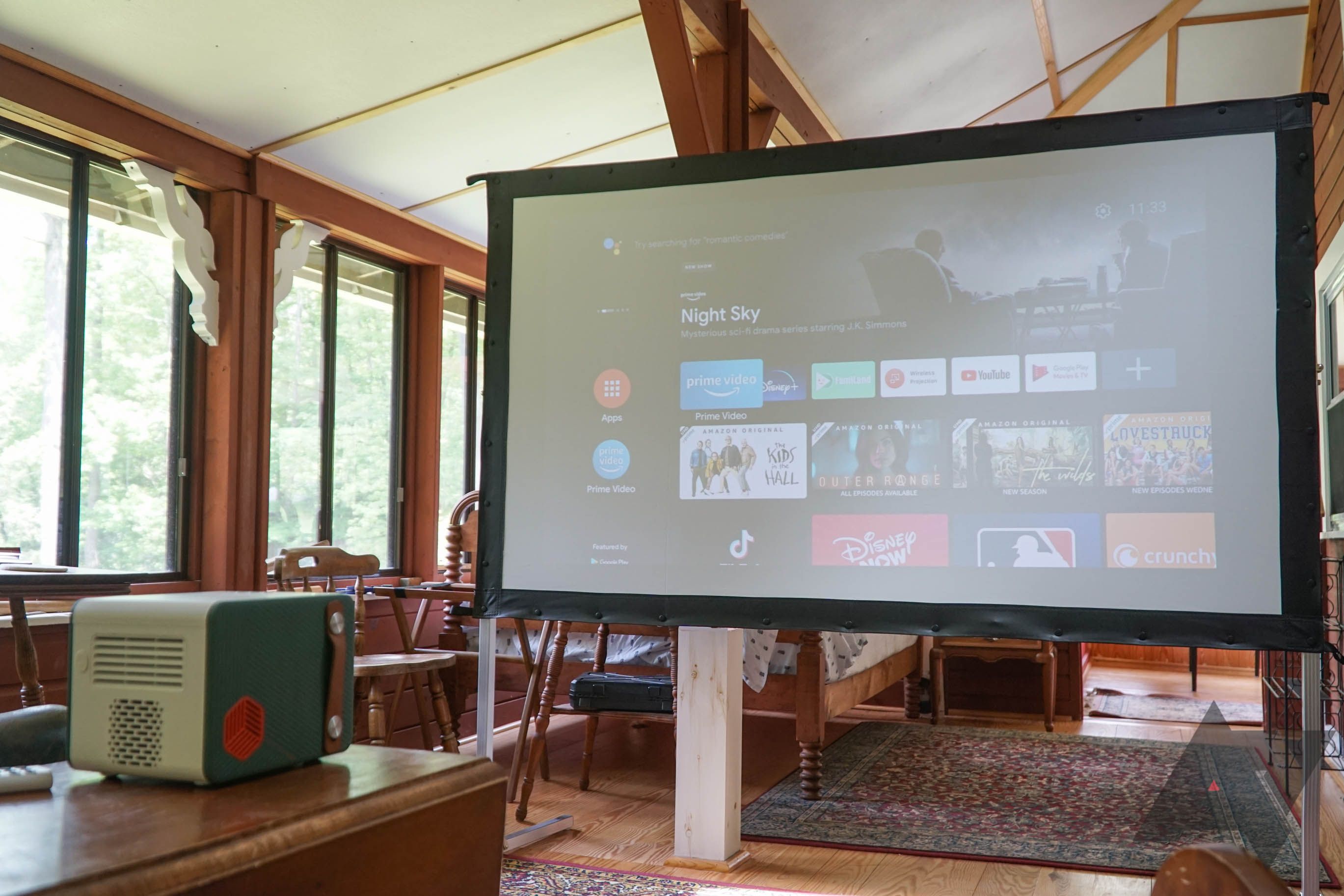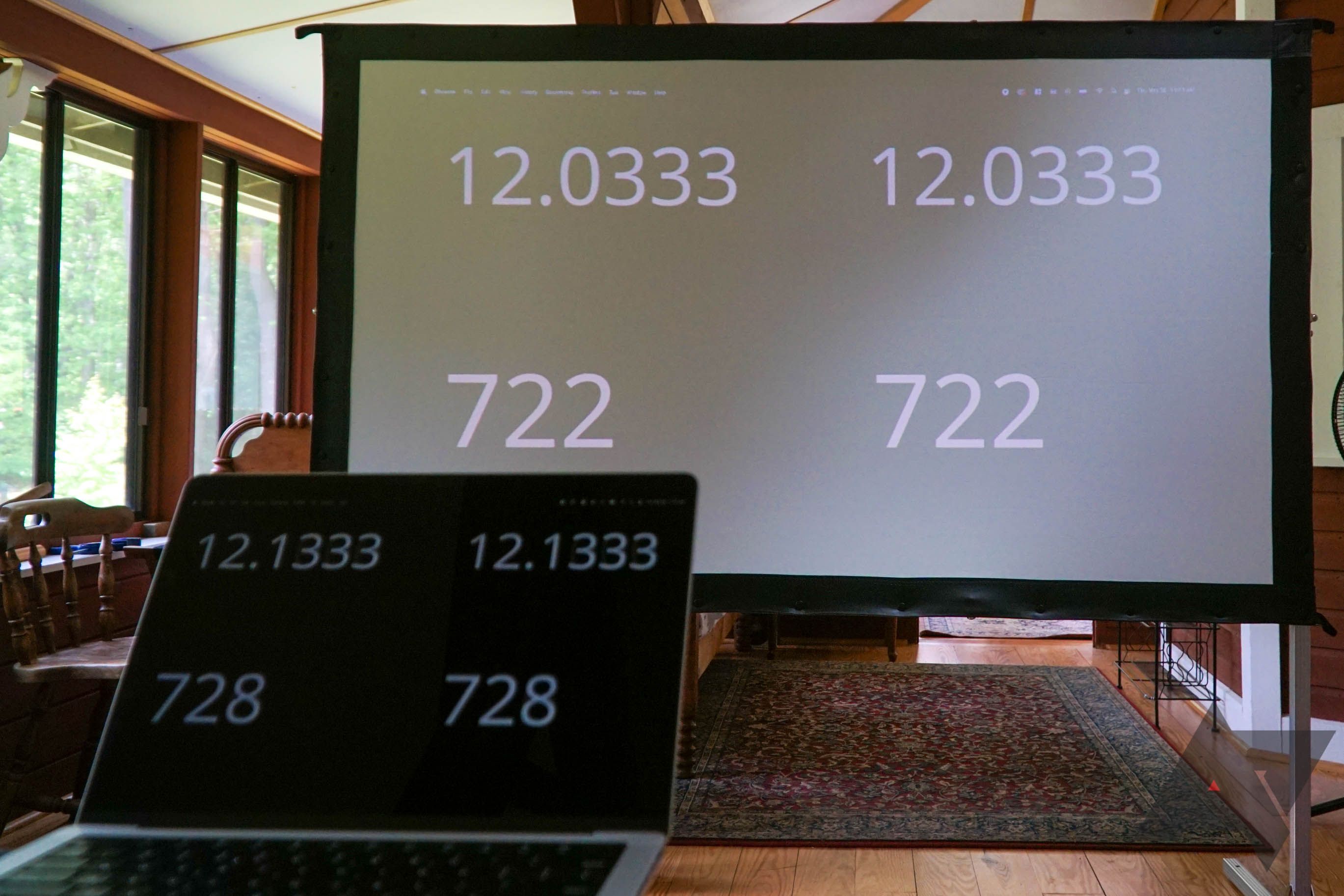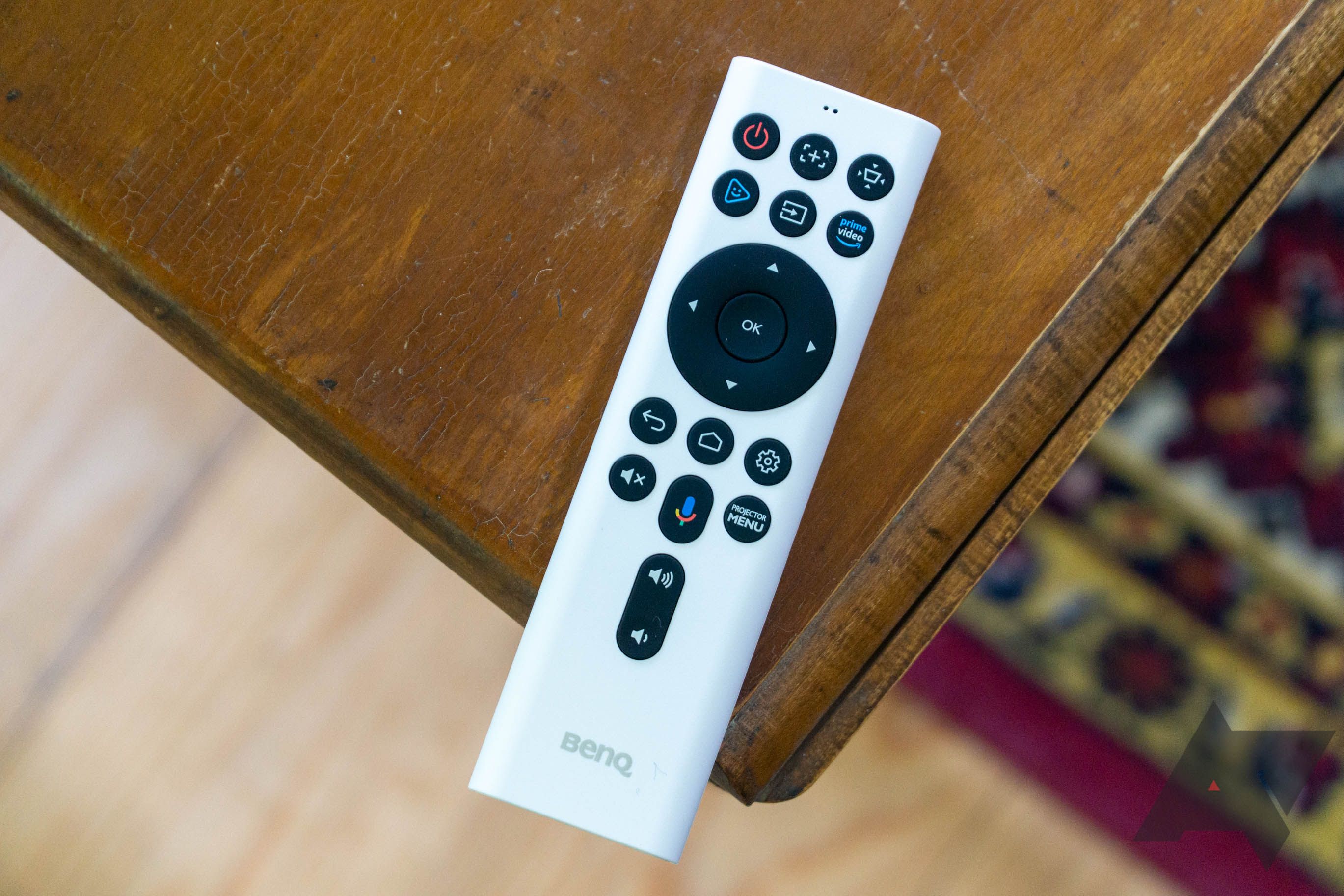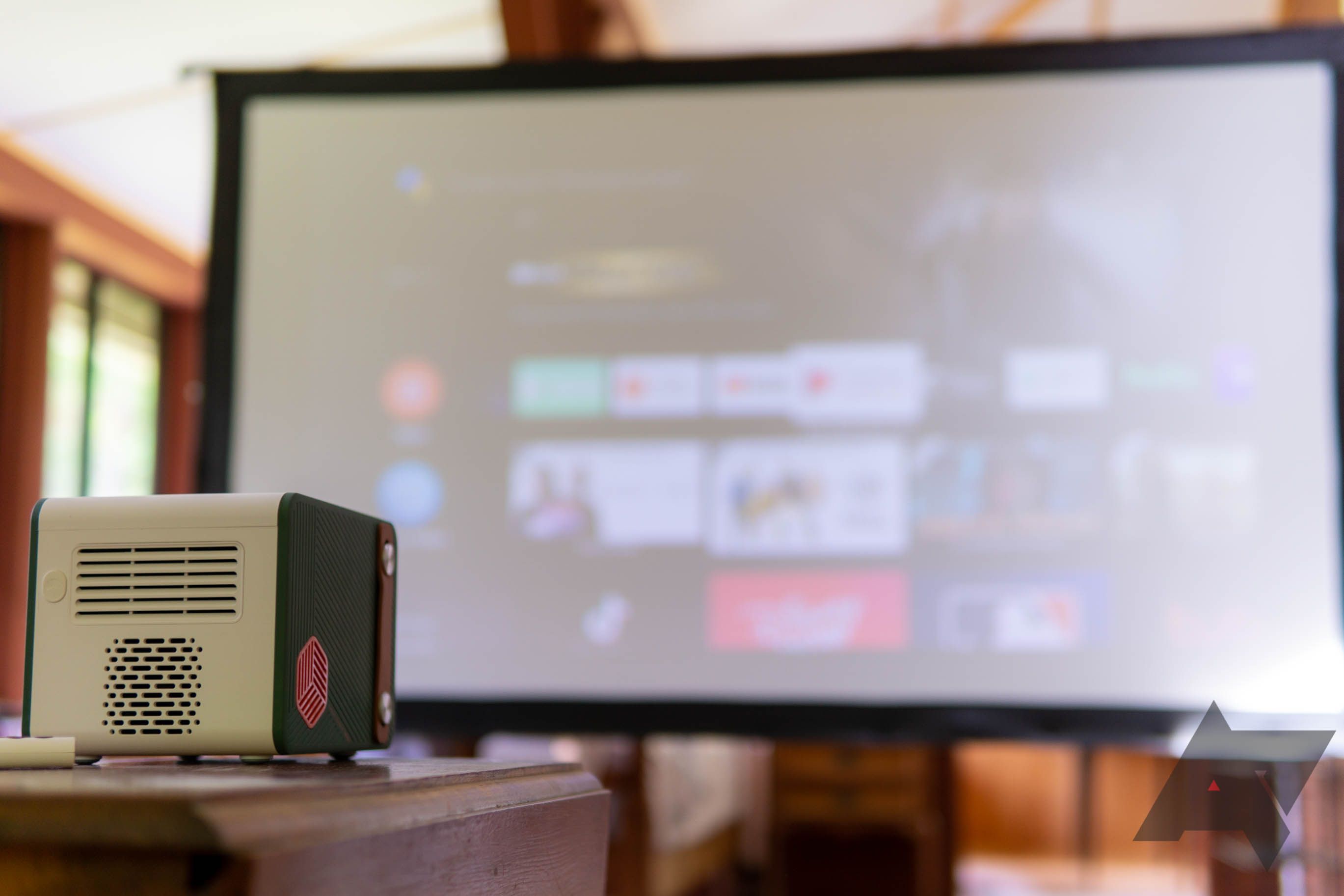Some of us wait all year with big, bright plans of summer fun, saving up our time and money to enjoy every minute of nice weather with outdoor activities. Even just watching a movie can be that much better under the stars or in the backyard. But if you plan on watching with friends or family, you might want to consider a portable projector, and the BenQ GS50 is a pretty good choice, with powerful sound and a big, bright picture you can even use during the day (in the shade, anyway).
BenQ GS50
The BenQ asks that you spend a little extra money than the average portable projector, but you get a bigger, better, brighter picture and improved audio because of it. It might be overkill at times, but it's worth it.
- Native Resolution: 1920 x 1080
- ANSI Lumens: 500
- Projection Technology: DLP
- Connectivity: Wi-Fi (a/b/g/n/ac, 2.4 & 5GHz), Bluetooth 4.2
- Throw Ratio: 1.21
- HDR: HDR10/HLG
- Audio: 2.1 channel (2x 5W + 10W)
- OS: Android TV (via included dongle)
- Lamp Life: 20,000-30,000 hours
- Image Size: 30-110", 60-100" recommended
- Maximum Supported Resolution: 640 x 480 to 4K UHD 3840 x 2160
- Lamp Type: LED
- Ports: 2x HDMI (one internal for dongle), 1x USB Type-C DisplayPort/charging, 1x USB Type-A, 1x 3.5mm audio output
- Size: 186x154x146 mm
- Weight: 5.07 lbs (2.3kg)
- RAM: 2GB
- Storage: 16GB
- Great picture for a portable projector.
- Good up to around 65-100 inches (depending on day/night and ambient light levels).
- Gets loud and has great sound quality.
- Durable design can withstand bumps, scrapes, and a light splash.
- Comes with an Android TV dongle and a zippered case.
- USB Type-C charging is good, but...
- Picky USB Type-C charging.
- 100ms input lag on USB-C DisplayPort.
- Expensive.
- No Netflix available on the included Android TV dongle.
Hardware
The BenQ GS50 is a unique-looking projector with a white and green body. Orange plastic grilles for the built-in speakers are inset on each side with a faux leather handle on the left and a cover for inputs on the right. There’s a button-activated telescoping kickstand on the bottom for tilting it up at an angle and a threaded hole for mounting it to a stand. On the back, you have a vent for the interior fan and a grille for the lower frequency woofer, plus a DC barrel charging port. Ports for input/devices are one of each for USB Type-C, HDMI, USB Type-A, and a 3.5mm audio output jack.
Sound via the advertised 2.1 speaker system (10W bass plus 2x 5W for the speakers) is surprisingly loud without being tinny or boomy, projecting to fill a space well. Something in my unit can sometimes buzz a little at high volume levels around a specific frequency (probably a button or an issue I had with a gasket I’ll touch on later), but the audio is surprisingly free of distortion unless you really crank it. There’s even an audio-only mode you can use that turns the projector into a glorified Bluetooth speaker.
Like most projectors, there’s a built-in fan. If nothing is being played, you’ll notice it immediately, though it can blend in as white noise after a while. But while content is being played, you can’t hear it over things like dialogue or ambient movie noises. Unless it’s a really quiet/suspenseful title, it probably won’t be an issue, but you will notice it if things are quiet, and it gets louder depending on the picture mode — “low power” is less noisy than “normal.”
BenQ says the GS50 projector is “splashproof” with an IPX2 rating. That means you shouldn’t use it in the rain, even if it’s just a light drizzle. The top cover for the Android TV dongle also has a gasket that protects it (though mine falls out easily when opening the top cover), and BenQ says the side ports for the speaker have a film of some kind inside to reduce water damage. These “light” IP ratings are harder to test, but I did splash the top of the unit with a bit of seltzer and allowed it to drip down the sides, and it didn’t die. I wouldn’t trust this sort of rating much past that, though.
It’s also allegedly “drop-proof” at up to 2.3 feet, an important feature for a portable projector, and that’s easier to test. Picking it up and dropping it about two feet onto the carpet while it was running, my image did lose its focus and the fan got a bit grindy for a second, but it kept running and refocused when put back in place just fine. If a rambunctious pet or kid knocks it off its perch, there’s a real chance it will survive, depending on how hard it hits the ground.
Connectivity options here include 2.4 and 5GHz Wi-Fi and Bluetooth 4.2, so you can connect to just about any network or pair it with other devices like a Bluetooth soundbar or gamepad if you really want to. As touched on before, it can also kick into a mode where it can become a Bluetooth speaker, disabling the projected image.
One of the things I was worried about while testing the projector was how tedious the setup process might be — determining focus, precisely aligning the keystone settings for a square picture, etc. Fortunately almost all of this can be automated away, though the auto-keystone is hit-and-miss. There’s also an auto-off feature if something gets too close to the projected light. That’s good if you have inquisitive children or curious pets that might stick an eye too close to the beam.
It also comes with a zippered nylon case that has room for extra cables or other small gadgets.
Image quality
During our original briefing, BenQ told us that it went to great pains to make sure the specifications it advertises on the GS50 aren’t… well, bullshit like so many other cheap portable projectors. Countless no-name Amazon brands claim to sell tiny, incredibly high resolution, absurdly bright portable projectors that never actually meet the claims made. BenQ merely advertises 500 ANSI lumens and a 1080p native resolution, and that’s exactly what you get.
A daytime worst-case example in "low-power" mode.
In software, it can take up to a 4K resolution or as low as a 480p picture, downscaling or upscaling as necessary to fit within the 1080p resolution. Ultimately, it’s up to you if 1080p is suitable for the image sizes you need. I spent most of my time using it in the 65-80” range and found the image to be sharp given the price and the use case, but obviously less sharp than an at-home 4K TV of a similar size. And while it isn’t bright enough for use in direct sunlight, the GS50 did fine when set up in the shade of my honestly quite sunny cabin deck.
I didn’t notice any substantial or distracting lag between the picture and the audio when using the built-in apps, as sometimes happens with projectors. BenQ says input latency is around 22ms, but my own testing using it as an external display from my laptop indicates somewhere around 6 frames of lag at 60Hz or around 100ms, though that could be specific to the Displayport Type-C input, or other factors may have been at play.
Relative latency measured using the USB Type-C DisplayPort input.
BenQ claims it supports 24-bit color and gets bright enough for HDR10/HLG. If you use it “wrong” with too big a picture or inadequate brightness, you won’t notice the benefits, but if you dial in the picture settings well enough, you should notice a difference when it kicks in — and, unfortunately, you will have to dial that in a little.
The default GS50 picture settings aren’t great, with overly aggressive sharpening kicked in to offset the otherwise slightly soft picture. I appreciate the intent, but you’re better off embracing a little softness than sacrificing detail quality to a sharpening algorithm. Crank that down, turn the brightness up, and then play with the contrast until shadows aren't crushed into oblivion.
In my testing, the picture is great at 80" and lower when used in the dark. 100” is still doable, but you lose some contrast, and you might need to crank brightness up a little. Much past that, consider a more powerful projector. In the shade during the day, you can’t go a lot larger than 65” at the maximum brightness setting without losing a distracting level of contrast — I’d consider that the upper limit. But if you are using it primarily at night, I think one could push it out to 100” or more depending on how much of a washed-out picture you’re willing to accept, and how bright the environment is. All of this lines up pretty well with BenQ’s rated numbers and I’m glad to see they were honest with their estimates.
You might be tempted to kick in the “bright” picture mode to eke out a larger image, but don’t fall for it. The picture quality in that mode is garish and green-tinted, but technically the brightest mode the projector offers. I find the “cinema” picture mode is the best balance between brightness and color for most content, and to my non-colorimeter-equipped-eye, it’s the most well-calibrated mode. I don’t have the gear to measure gamma or color accuracy, but I think it’s generally close enough, if sometimes just a little oversaturated in the way most people like. The “daylight” mode is just a little brighter during daytime use, but colors become very oversaturated. The uniformity of brightness in the projected image is also quite good to the naked eye.
Photos aren't the best format to demonstrate this, but: "Normal" (left) vs "low power" (right) picture (both at maximum brightness) with a 65" picture size during the day in the shade. Quality in dimmer lighting or at night (below) is almost arbitrarily good up to around 80" in size, depending on brightness settings.
Among the few things about the picture that did bother me is a slightly annoying flicker when it detects HDR video content being played and adjusts the display to better suit it, but that only happens when it kicks into gear at the beginning, it’s not an ongoing problem during playback. BenQ’s auto-adjust brightness feature could also use a greater range of control. It’s supposed to enhance contrast and detail, but it isn’t as granular as it could be, and sometimes I can detect the change in brightness when it’s making an adjustment during playback.
Even once you have the picture on the GS50 dialed in as best as you can, the contrast ratio isn't stunning. Blacks are hardly objectively black, more of a middle gray. It gets better if you spend a little time tinkering, though it won’t rival a modern flat-panel TV or a more expensive at-home projector. But that’s not a fair comparison, and I don’t think anyone in the market for a portable projector is actually comparison shopping with one. This is for camping, handing to the kids for a bit of fun in the backyard, or inviting the neighbors over to watch a flick with some cocktails on the deck, and the image quality is perfectly suited for that.
For an $800 mini projector, this has a pretty decent picture that can get decently big and surprisingly great audio, just don’t expect inky blacks or daylight-fighting brightness at larger image sizes.
Software
The BenQ GS50 runs Android TV — or, at least, it can run Android TV, if you want it to. Rather than being built into the projector like you might expect, there’s a physical space inside the projector with a dedicated HDMI video input and power connection for you to install a bundled Android TV dongle. The enclosure is easy to open and a little more of a pain to shut (the gasket on mine really likes to fall out and block it from closing correctly), but I think this is actually a better approach than building Android TV functionality in. If and when the dongle stops getting updates, you can replace that hardware and the projector itself should still be good. That assumes that BenQ releases a new version of the dongle that’s compatible, though.
I figured photos of the interface here helped further demonstrate a sort of "worst case" picture quality in daytime lighting, since Android TV has a relatively dark UI.
With a little creative engineering or some light modification, it might be possible to shoehorn in an entirely different Android TV dongle, though power is supplied via Micro USB. I considered trying to shove a Chromecast with Google TV in it, but it can’t be directly supplied power by the enclosure, though splicing up a custom cable and carving out some extra space might address that.
Although the Android TV functionality is technically separate from the projector hardware itself, the bundled remote controls both the projector and the dongle, which is convenient, and it seems to work reliably even without infrared line-of-sight. The remote accepts voice input for commands, though it can be a little slow to capture and process them compared to other more recent Android TV devices. There are separate buttons for the Android TV settings menu and the projector’s built-in settings — unlike a standalone Android TV that you might have used, things like brightness and color options live outside of Android TV in this other hardware menu, and it’s how you can view the current battery level. There’s also a dedicated button for Amazon’s Prime Video and another to fire up BenQ’s FamiLand Kids Channel — itself nothing more than a kids-themed YouTube scraper, apparently. Neither of these things really needed their own button.
If you’ve used Android TV before, you should be familiar with what this is like. You’ve got the standard Android navigation scheme with a home and back button, a menu for settings, the ability to keep multiple apps running, and the ability to download and install new ones as required.
Almost all the apps you would expect to have on Android TV or a streaming device are available, like Hulu, Amazon Prime Video, Disney+, HBO Max, and even more niche services like The Criterion Channel. Unfortunately, the projector’s Android TV guts aren’t compatible with Netflix for whatever reason. BenQ’s sanctioned method for enjoying Netflix is a convoluted recipe for frustration where you cast it from something like your laptop:
In other markets, BenQ straight-up tells customers to just sideload Netflix from an unofficial source like Aptoide TV. Sideloading apps on Android TV is, at best, an obnoxious process, and you’ll run into problems downloading updates later. Whatever the limitation is here, I wish it were something BenQ would address, but you can work around it if you need to.
In the apps it can easily use, the projector happily spits a high resolution picture with support for things like HDR in compatible titles, so there don’t appear to be any DRM issues that might limit playback quality (likely ruling that out as a reason for the lack of Netflix).
While you can install things like games onto the Android TV image, I’d encourage you not to. There isn't a lot of oomph here to power them.
Battery life
Using it at night at a middling brightness level, I saw a little shy of three hours of life in the “low power” mode — I think that’s probably the way most people will end up using it. If you’re very careful and keep brightness down pretty low, I think it might be possible to beat three hours, but you’d have to sacrifice a lot in image quality to do it, and you’d likely end up using a very small picture. Pushing everything to the max for use during the day, I was able to drop that to around one and a half hours. In short, this is a one-movie projector — or two, if you’re careful and you like short flicks.
That’s not quite as long as some other portable projectors last. The Anker Nebula Mars II hit four hours in our review, though it has much lower-end specs, and the same is true of the XGIMI MoGo Pro. That’s a trade-off that seems inevitable: A bigger, better, brighter picture means a drop in battery life.
There is one annoying quirk about the projector when it gets to a low battery level. Once you hit 20%, it spits a warning that the battery is low, and this can kill running apps (or at least it did for me). It also forces you into the “low power” mode with diminished brightness, and when the battery is low, you can’t disable it.
Ostensibly, the projector can charge using just USB Type-C and Power Delivery, but it seems to be particularly picky about the chargers it will work with. Specs state it only supports a 45W input, but I’m not sure what specific PDO/voltage it requires or if it needs some other special consideration. Whatever the limitation, I found the experience was hit-or-miss and couldn’t be relied upon.
It could simply be counter-intuitive because of how quickly it drains power, but the projector takes a little longer to top up than you might expect. I haven’t sat and timed it (because I can’t sit around for hours watching it), but it seems to take at least three hours to hit full sometimes.
Should you buy it?
If you need a projector that can go with you, yes. The only caveat I can really present for buying the BenQ GS50 is the price tag. $800 is a decent chunk of change, and you can get portable projectors for cheaper than this, including BenQ’s own GV30 (which we’re also taking a look at). We’ve reviewed other projectors that cost a little less but sacrifice brightness and audio quality. But that’s ultimately why this is an $800 product, and it justifies the price.
Yes, you can get a cheaper portable projector, and that might even be fine for whatever use you had in mind. If all you care about is projecting a two-foot image to the inside of a camping tent or a kid’s bedroom wall, and things like picture quality and resolution don’t even enter into the equation, this is overkill. But if you want to have some friends over for an outdoor party and need a projector that can fight your backyard string lights while still providing a six-foot image, with the oomph to thump loud enough that it can be heard among the conversation, then I think this is a good choice.
With companies like Anker selling the otherwise well-regarded 720p Mars II Pro for $550, the extra $250 here is well spent on better audio and a higher-resolution picture.
If you do pick one up, I recommend you get a purpose-made projector screen for it, as the surface makes a huge difference in brightnes, color, and contrast. They come in all sorts of varieties, from ones with big metal frames and stands to a loose sheet you can hang from hooks. The improvement to picture quality compared to a wall is huge, they don’t cost much compared to the projector itself, and they’re absolutely worth it.
Buy it if:
- You want a more premium portable projector and can afford it.
- You’d like some built-in smarts, good audio quality, and a (relatively) bright image.
- It needs to be durable — this can survive a few tumbles and a spritz of water.
Don’t buy it if:
- You don’t need to project a picture that’s bigger than 3 feet or so ( a cheaper and dimmer projector will do fine).
- You need to project an image larger than 100 inches or use it primarily during the daytime (consider a more powerful, wired projector and a portable generator maybe).
- You’re on a strict budget.
FAQ
Q: How does the BenQ GS50 compare to the Anker Nebula Mars II Pro?
Anker's portable projectors are pretty popular, just about defining the product category for many customers, but the GS50 is a more premium product compared to the Mars II Pro. While Anker's projector is usually available between $600-550, it has a lower-resolution display, though a similar watt-rating for audio and similar rated brightness. The software experience on Anker's model is also more janky, as it uses a heavily modified and ancient version of Android rather than Android TV, and customers frequently report issues with app compatibility.
The BenQ GS50 runs actual Android TV, works better with apps, and has a sharper image, and we think it's worth the premium.
Q: How does the BenQ GS50 compare to the Anker Nebula Cosmos?
While we haven't had a chance to use the Nebula Cosmos, it hits a similar price and has some specs compared to the BenQ GS50, excluding one key detail. Anker claims it hits 900 ANSI lumens, which is much brighter for use in daytime or at larger sizes at night. However, there's no battery.
If you plan to use the Nebula Cosmos out and about, you'll need to plug it into an extension cord or portable generator. For some people, that might be a better choice — if you plan to use the projector near an outdoor outlet or your car most of the time. But if you want the flexibility of a truly portable projector, the GS50 has the inherent edge here.
Q: How does the BenQ GS50 compare to the Samsung "The Freestyle?"
Samsung's The Freestyle caught a lot of attention when it was released earlier this year, and at $900 it's near the same price as the BenQ GS50. While a quick glance at the specs indicates it should be competitive, customer reports indicate it comes nowhere near its rated brightness, software is bad, and the swiveling mount can't hold an angle reliably. It also doesn't come with its own battery, and though a separate base was ostensibly planned in some markets, it has yet to materialize in the US. The Freestyle does work with Netflix out of the box, though.
You can spend more for less with The Freestyle if you really want to, but the GS50 is probably a better choice.

